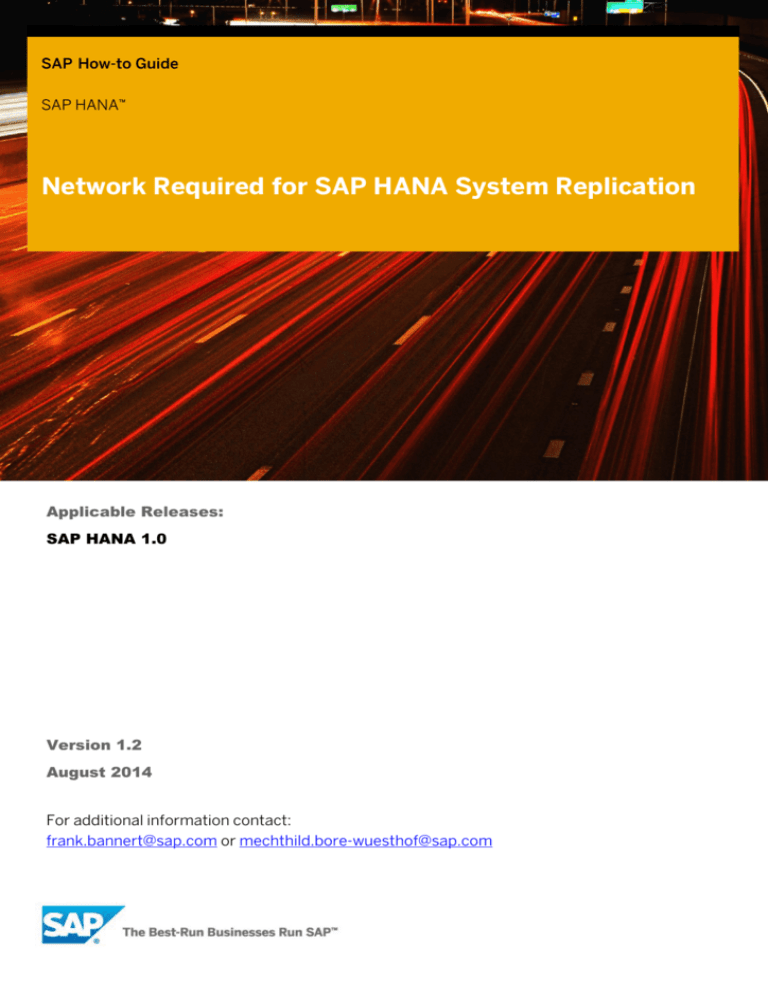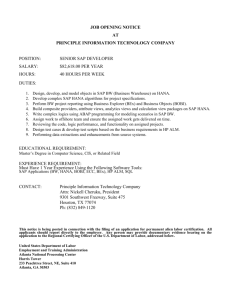
SAP How-to Guide
SAP HANA™
Network Required for SAP HANA System Replication
Applicable Releases:
SAP HANA 1.0
Version 1.2
August 2014
For additional information contact:
frank.bannert@sap.com or mechthild.bore-wuesthof@sap.com
© Copyright 3 SAP AG. All rights reserved.
All other product and service names mentioned are the trademarks of
No part of this publication may be reproduced or transmitted in any form
their respective companies. Data contained in this document serves
or for any purpose without the express permission of SAP AG. The
informational purposes only. National product specifications may vary.
information contained herein may be changed without prior notice.
The information in this document is proprietary to SAP. No part of this
Some software products marketed by SAP AG and its distributors
document may be reproduced, copied, or transmitted in any form or for
contain proprietary software components of other software vendors.
any purpose without the express prior written permission of SAP AG.
Microsoft, Windows, Excel, Outlook, and PowerPoint are registered
This document is a preliminary version and not subject to your license
trademarks of Microsoft Corporation.
agreement or any other agreement with SAP. This document contains
IBM, DB2, DB2 Universal Database, System I, System i5, System p,
System p5, System x, System z, System z10, System z9, z10, z9, iSeries,
pSeries, xSeries, zSeries, eServer, z/VM, z/OS, i5/OS, S/390, OS/390,
OS/400, AS/400, S/390 Parallel Enterprise Server, PowerVM, Power
Architecture, POWER6+, POWER6, POWER5+, POWER5, POWER,
only intended strategies, developments, and functionalities of the SAP®
product and is not intended to be binding upon SAP to any particular
course of business, product strategy, and/or development. Please note
that this document is subject to change and may be changed by SAP at
any time without notice.
OpenPower, PowerPC, BatchPipes, BladeCenter, System Storage, GPFS,
SAP assumes no responsibility for errors or omissions in this document.
HACMP, RETAIN, DB2 Connect, RACF, Redbooks, OS/2, Parallel Sysplex,
SAP does not warrant the accuracy or completeness of the information,
MVS/ESA, AIX, Intelligent Miner, WebSphere, Netfinity, Tivoli and
text, graphics, links, or other items contained within this material. This
Informix are trademarks or registered trademarks of IBM Corporation.
document is provided without a warranty of any kind, either express or
Linux is the registered trademark of Linus Torvalds in the U.S. and other
countries.
Adobe, the Adobe logo, Acrobat, PostScript, and Reader are either
trademarks or registered trademarks of Adobe Systems Incorporated in
the United States and/or other countries.
Oracle is a registered trademark of Oracle Corporation.
UNIX, X/Open, OSF/1, and Motif are registered trademarks of the Open
Group.
Citrix, ICA, Program Neighborhood, MetaFrame, WinFrame, VideoFrame,
and MultiWin are trademarks or registered trademarks of Citrix Systems,
Inc.
HTML, XML, XHTML and W3C are trademarks or registered trademarks
of W3C®, World Wide Web Consortium, Massachusetts Institute of
Technology.
implied, including but not limited to the implied warranties of
merchantability, fitness for a particular purpose, or non-infringement.
SAP shall have no liability for damages of any kind including without
limitation direct, special, indirect, or consequential damages that may
result from the use of these materials. This limitation shall not apply in
cases of intent or gross negligence.
The statutory liability for personal injury and defective products is not
affected. SAP has no control over the information that you may access
through the use of hot links contained in these materials and does not
endorse your use of third-party Web pages nor provide any warranty
whatsoever relating to third-party Web pages.
SAP “How-to” Guides are intended to simplify the product implementtation. While specific product features and procedures typically are
explained in a practical business context, it is not implied that those
features and procedures are the only approach in solving a specific
Java is a registered trademark of Sun Microsystems, Inc.
business problem using SAP NetWeaver. Should you wish to receive
JavaScript is a registered trademark of Sun Microsystems, Inc., used
additional information, clarification or support, please refer to SAP
under license for technology invented and implemented by Netscape.
Consulting.
SAP, R/3, SAP NetWeaver, Duet, PartnerEdge, ByDesign, SAP
Any software coding and/or code lines / strings (“Code”) included in this
BusinessObjects Explorer, StreamWork, and other SAP products and
documentation are only examples and are not intended to be used in a
services mentioned herein as well as their respective logos are
productive system environment. The Code is only intended better explain
trademarks or registered trademarks of SAP AG in Germany and other
and visualize the syntax and phrasing rules of certain coding. SAP does
countries.
not warrant the correctness and completeness of the Code given herein,
Business Objects and the Business Objects logo, BusinessObjects,
and SAP shall not be liable for errors or damages caused by the usage of
Crystal Reports, Crystal Decisions, Web Intelligence, Xcelsius, and other
the Code, except if such damages were caused by SAP intentionally or
Business Objects products and services mentioned herein as well as their
grossly negligent.
respective logos are trademarks or registered trademarks of Business
Disclaimer
Objects Software Ltd. Business Objects is an SAP company.
Some components of this product are based on Java™. Any code change
Sybase and Adaptive Server, iAnywhere, Sybase 365, SQL Anywhere,
in these components may cause unpredictable and severe malfunctions
and other Sybase products and services mentioned herein as well as their
and is therefore expressively prohibited, as is any decompilation of these
respective logos are trademarks or registered trademarks of Sybase, Inc.
components.
Sybase is an SAP company.
Any Java™ Source Code delivered with this product is only to be used by
SAP’s Support Services and may not be modified or altered in any way.
Document History
Document
Version
Description
1.0
First official release
1.2
Fixed error in SQL statement
Typographic Conventions
Icons
Type Style
Description
Icon
Example Text
Words or characters
quoted from the screen.
These include field
names, screen titles,
pushbuttons labels,
menu names, menu
paths, and menu
options.
Cross-references to
other documentation
Example text
Emphasized words or
phrases in body text,
graphic titles, and table
titles
Example text
File and directory
names and their paths,
messages, names of
variables and
parameters, source
text, and names of
installation, upgrade
and database tools.
Example text
User entry texts. These
are words or characters
that you enter in the
system exactly as they
appear in the
documentation.
<Example
text>
Variable user entry.
Angle brackets indicate
that you replace these
words and characters
with appropriate entries
to make entries in the
system.
EXAMPLE TEXT
Keys on the keyboard,
for example, F2 or
ENTER.
Description
Caution
Note or Important
Example
Recommendation or
Tip
Network Bandwidth for SAP HANA System Replication
1.
Before you start
It is recommended to have read the SAP HANA system replication sections in the
following documents:
SAP HANA Master Guide:
http://help.sap.com/hana/SAP_HANA_Master_Guide_en.pdf
SAP HANA Server Installation Guide:
http://help.sap.com/hana/SAP_HANA_Server_Installation_Guide_en.pdf
HowTo guide on System Replication:
https://scn.sap.com/docs/DOC-47702
You should also be aware of these SAP notes containing valuable information on
SAP HANA system replication:
2.
SAP Note 1876398 - Network configuration for System Replication in HANA
SP6
Network recommendation
The following two requirements should be met when deciding on the network
bandwidth for SAP HANA System Replication:
1. “Throughput”: It must be possible to transport the size of the persistently
stored data within one day from the primary to the secondary.
2. “Latency”: The redo log shipping wait time for 4 KB log buffers must be less
than a millisecond or in a low single-digit millisecond range – depending on
the application requirements (relevant for synchronous replication only).
Here are some further explanations resp. examples regarding the two
requirements:
Ad (1)
For example:
Given:
4,3 TB of persistently stored data.
Throughput: 4,3 TB/day ~ 50 MByte/s
=> ~0,5 GBit/s connection required
1
Network Bandwidth for SAP HANA System Replication
The following statement can be used to determine the size of the used
persistence:
select host, port, data_volume_name,
round (sum(used_block_count * page_size) / 1024 / 1024 / 1024, 3)
as "Persistent Data Size GB"
from m_data_volume_page_statistics
group by host, port, data_volume_name
Ad (2)
All changes to data are captured in the redo log. The SAP HANA database
asynchronously persists the redo log with I/O orders of 4 KB to 1 MB size into
log segment files in the log volume (i. e. on disk). A transaction writing a commit
into the redo log waits until the buffer containing the commit has been written
to the log volume. This wait time for 4 KB log buffers should be less than a
millisecond or in a low single-digit millisecond range.
With the SQL statement HANA_Replication_Overview (attached to SAP Note
1969700) you can collect the local and the remote log write wait times:
Local redo log write wait times
The log write wait times on the “local” system (i.e. on the persistence of the
primary site) is returned by the mentioned SQL statement as “Avg. local log
buffer write time (ms)” per service, where the index server is the one of
interest.
System replication redo log shipping wait time
Additionally the mentioned SQL statement returns the redo log write latency
for the shipping to the secondary which can be slightly higher than the
locally measured log write wait time. The returned value “Avg. log buffer
shipping time (ms)” represents the time period between enqueueing and
finishing a request.
2
www.sap.com/contactsap
www.sdn.sap.com/irj/sdn/howtoguides









